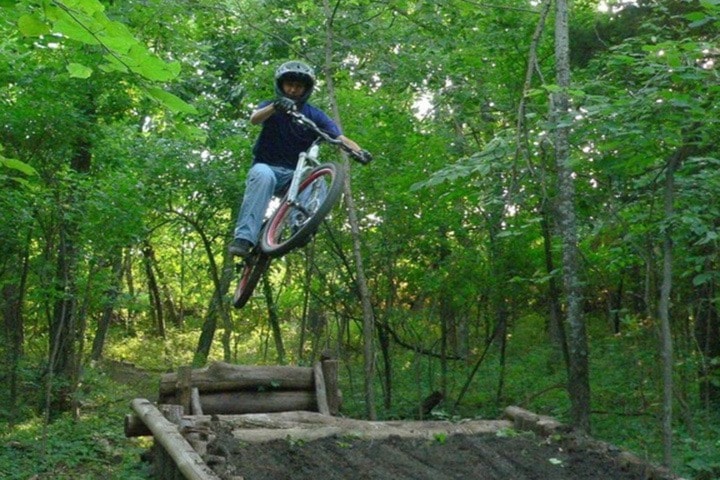It has been a policy waiting to happen.
The province has never authorized mountain bike trails on Crown land, not knowing how to manage the risk inherent in the sport.
As a result, the province has iterated it would not allow any technical features—like jumps or bridges and all of the things advanced bikers like to build up to make trails more challenging—unless local cycling or trail organizations obtained independent insurance coverage.
That has been difficult and, in many cases, unachievable for some volunteer-run organizations to purchase, so many trails were deemed unauthorized and, therefore, were uninsured.
That will be changing, but it comes at a cost.
Recreation Sites and Trails BC (RSTBC) will be authorizing (and insuring) trails located on Crown land and specific technical features, but it has subject them to a very particular set of rules.
Although mountain bike trails on Crown land will now be insured, there has been a definite limit put to the degree of risk the province will accept—width of a feature, certain characteristics only are acceptable—in order to give its blessing, said Stewart Spooner, Kootenay Columbia Trail Society (KCTS) trails manager.
In order to gain authorization for a trail on Crown land, organizations will be required to put together a reporting protocol whereby they have to identify each feature, record it with a GPS, measure it, and then prove through an ongoing reporting schedule the trails continue to meet requirements.
Its an onerous and cumbersome process, and adds more layers of bureaucracy to organizations already stretched thin.
“Definitely it will create a limit as to what is possible to do on Crown land,” said Spooner. “The most advanced bikers are not going to be satisfied, but it is also putting a large onus on organizations to do a whole lot of extra work to document what they have, and maintain what they have.”
In Rossland KCTS has not been building really advanced trails, he added, and the majority of the trails in the area are on private land. The implications of the change on those trails is not going to felt, Spooner noted.
KCTS has land use agreements in place with the private landowners, and its own insurance in place. However, the new changes will affect popular trails such as Seven Summits, Plewman and Old Glory, as well as trails like Larch Ridge and Full Monte, which all fall on Crown land.
There are a few unauthorized trails with advanced features in out-of-the-way locations, Spooner noted, built by a small percentage of the local riders.
The features KCTS has constructed typically fall within the new provincial guidelines, he pointed out, so it will only be a matter of recording and maintaining them to receive coverage.
“We're haven't taken on covering that (advanced) end of the spectrum anyway. We're building for most people ... The most skilled riders and the most advanced riders will be looking for something beyond what we can provide,” he said.
The new ruling could have broader implications as it plays out, Spooner predicted, with the changes eventually governing trails on private land.
“My fear is it that will happen,” he said. “We're not sure how much of a carry over there will be to private land, ... but I'm anticipating we will have to do this level of reporting on our regular trails, not just features, and it will involve more bureaucracy rather than important stuff of building and fixing trails.”
editor@rosslandnews.com
Managing Recreation Sites and Trails
Maintaining or developing recreation sites and trails on Crown land requires authorization by RSTBC. The level of maintenance at a site or trail depends on the type of structures present, environmental conditions and the amount of use.
Maintenance activities are designed to ensure safety, provide sanitary conditions, protect the environment, ensure access and convenience, and maintain facilities and infrastructure.
Trail authorization
People planning to construct, rehabilitate or maintain a trail or recreation facility must prepare a written proposal and obtain authorization, prior to commencing works.
Applications can be submitted to Front Counter BC for processing and submission to the appropriate district recreation officer.
Development of trails
Recreation site, trail or facility development involves basic procedures related to layout, right-of-way clearing, construction of roads, trails, camping pads and other facilities, building and placement of structures and landscaping.
Each of these procedures has certain principles to be considered, depending on the specifications presented in the development plan.
A partial list of most common site and trail infrastructure and approved designs can be found at http://www.sitesandtrailsbc.ca/about/infrastructure-drawings.aspx.
Source: Recreation Sites and Trails BC
Trail work
Work is progressing on the extension of the Bluffs trail down to Sunningdale in Trail, and should be finished this fall.
Once that happens, crews will begin work on extending the Upper Redhead trail project on the lower third of Red Mountain. That trail extension will take some traffic off of Red Top trail.
The next couple of weeks will be focused on getting Seven Summits trail open, even though the snow hasn't quite completely melted yet. There is a lot of trail to maintain, said Spooner, and will require a couple of weeks work.
Crews will be getting rocks off the trail, fixing features and trail beds that have worn out and cutting trees out that have fallen.
“It's a pretty remote place to work in and there is a lot of work to do,” Spooner said. “So, hopefully, the trail will be in great condition by the time the snow melts off of it and we'll be able to ride it.”
